- Lake Victoria’s commercial fish stocks have plummeted due to overfishing, invasive species, pollution, and changing climatic conditions, among other factors.
- Now fishermen, researchers, and government officials alike are embracing cage aquaculture as a way to boost profits and fish supplies, as well as give the lake’s free-swimming fish a reprieve.
- However, cage fish farming has caused problems elsewhere in the world, in part due to the use of chemicals and the release of waste products, such as dead fish, uneaten feed, and feces.
For the past ten years Kenya and Uganda have been engaged in a fierce tussle over Migingo Island in Lake Victoria. A low slab of rocky land less than the size of a football pitch, Migingo is covered end to end with fishermen’s shacks. The battle has seen the Ugandan government deploy armed officers to control activities on the island, which is perceived to be on the Kenyan side of the lake.
The two countries are fighting over a resource whose scarcity has national implications: fish.
Migingo is surrounded by rich underwater biodiversity and thus attracts a lot of fish, making it one of the last lucrative hunting grounds on the lake for fishermen from the two countries.
“Migingo is the only place on the lake where we are sure of big and sufficient catches, now that fish is getting scarce and scarce in many other fishing grounds,” Nicholas Omondi, who has been a fisherman on Lake Victoria for 33 years, told Mongabay.
Lake Victoria, the second largest freshwater body in the world, yields more than 800,000 metric tons of fish each year that support the livelihoods of nearly 2 million people. But the lake’s fish stocks are declining amid growing demand, and so fishermen, researchers, and government authorities are enthusiastically turning to aquaculture to address the problem, particularly on the Kenyan side.
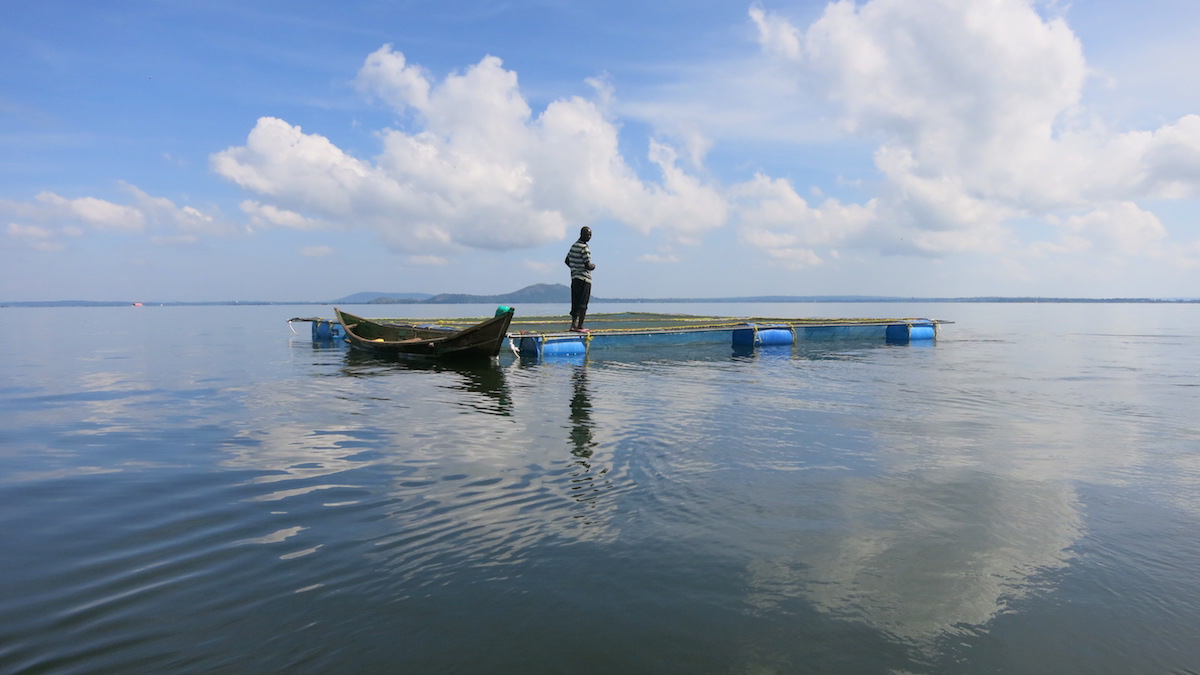
“The much-reported decline of capture fisheries in Kenyan natural waters is a clear indication that aquaculture needs to mitigate the burden of fish shortages,” Jonathan Munguti, a senior research officer and head of the Aquaculture Division at the Kenya Marine and Fisheries Research Institute (KMFRI), told Mongabay.
Pressures on the lake’s fish include overfishing and the use of illegal fishing gear, invasion by the alien water hyacinth (Eichhornia crassipes), industrial and municipal pollution, changing climatic conditions, and the introduction of the carnivorous Nile perch (Lates niloticus), which preys on numerous fish species and has driven many nearly extinct.
Farming fish instead of hunting them
It was in 2009, at the height of the tussle over Migingo Island, that the Kenyan government launched its Fish Farming Enterprise Productivity Program to inject commercial thinking into fish farming. The goal was to build up a vibrant aquaculture industry, mainly through pond-based fish farming on land.
But of late, the fish farmers have taken the aquaculture business to the lake, where they are now rearing fish in floating cages. Experts have high hopes that cage aquaculture will revolutionize the fish industry in East Africa, improve fish stocks on the over-fished lake by reducing hunting pressure on free-swimming fish, and reduce fishy international quarrels over Migingo Island.

In cage aquaculture fishes are reared to maturity in an enclosure that exchanges water freely with its surroundings. In Kenya, the cages are built of metal bars, wire mesh, and durable nets, with ordinary plastic tanks to keep them afloat on the lake and to act as wave breakers. Farmers place the cages strategically inside the lake, and feed the fish daily.
Globally, many countries are adopting cage aquaculture, but this is the first time East African countries have brought it to a commercial scale amid trials by governments and research institutions.
“Our preliminary research findings show that cage aquaculture is a viable business on Lake Victoria, far better than use of canoes to hunt for wild fish,” Wellington Otieno told Mongabay. Otieno is a professor of biological sciences at Kenya’s Maseno University, where he serves as principal advisor for the Lake Victoria Comprehensive Research for Development (LAVICORD) project. The project’s aim is to address the overexploitation of wild fish, aquaculture technologies, and pollution in the lake.
So far Nile tilapia (Oreochromis niloticus), an introduced species, the only fish raised in cages for commercial purposes on the lake. Recently, LAVICORD, a collaboration between Maseno University and Japan’s Nagasaki University, has demonstrated that it is possible to raise the carnivorous Nile perch in cages, as well.
“It is the easiest because you do not need to feed the fish in the cages,” Helen Marcial, an aquaculture expert with Nagasaki University, told Mongabay. Since Nile perch have large bodies, their cages allow smaller fish from the surrounding environment to freely swim in and out, providing a ready food supply for the captive perch. The cages are fitted with lights to attract smaller fishes.
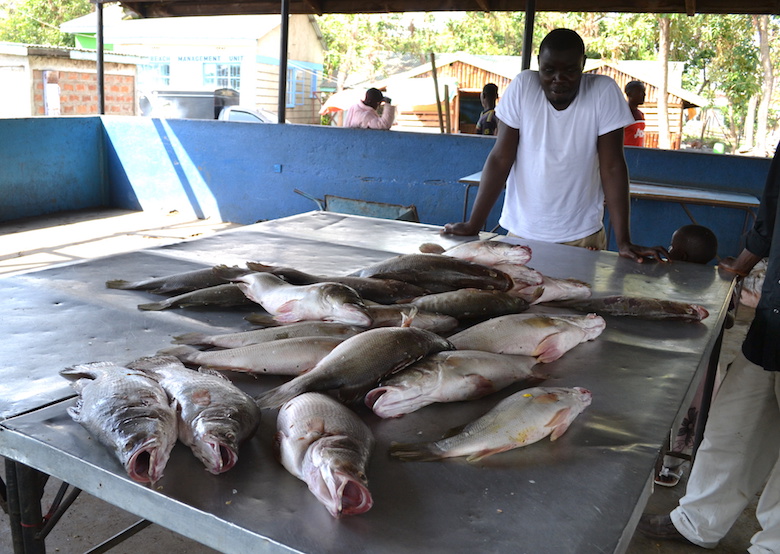
The species poses a unique conundrum on the lake. It was introduced to the lake in the 1950s to boost the fishing industry, and has driven the decline of many native fishes. However, it is also the most sought after fish in the lake — a fact that has caused its own numbers to crash.
“The Nile perch fetches more money than any other fish in this lake because they are usually very huge, and fleshy. That’s why most of us go for it,” said Peter Owuor, a fisherman at Dunga Beach in Kisumu City.
Munguti of KMFRI said that despite the Nile perch being a threat to other fish species, it contributes a lot to the country’s income, especially via exports. The species constitutes 90 percent of the fish exported from the lake to Europe, he told Mongabay.
And now, because it is also imperiled due to high demand, KMFRI has embarked on a comprehensive research process to save the carnivorous species from growing human appetites. Munguti said that KMFRI is in the process of establishing an International Nile Perch Research Centre in Kisumu City, where the institute will explore means of restoring the species while at the same time taking care of the indigenous species it eats.
For better or worse, experts are optimistic that modern fish farming techniques will make it possible to do just that.
New guidelines for a new industry
KMFRI is collaborating with its counterparts in Uganda and Tanzania to develop guidelines and policies that will govern cage aquaculture on Lake Victoria, which is a shared resource for the three countries.
Aquaculture experts from the three countries are holding rounds of negotiations, exploring advantages and disadvantages of the cage technology, its profitability to the region’s economy, and its impact on the environment. They are also discussing how to tackle various challenges that have arisen, such as invasive weeds clogging the cages, poor construction of cages, and stocking of low-quality fingerlings.
Even as the negotiations unfold, there are already hundreds of floating cages on the lake, some of them owned by individual fish farmers for commercial purposes, others by institutions for research, including KMFRI, Maseno University, and Kenya’s Jaramogi Oginga Odinga University of Science and Technology.
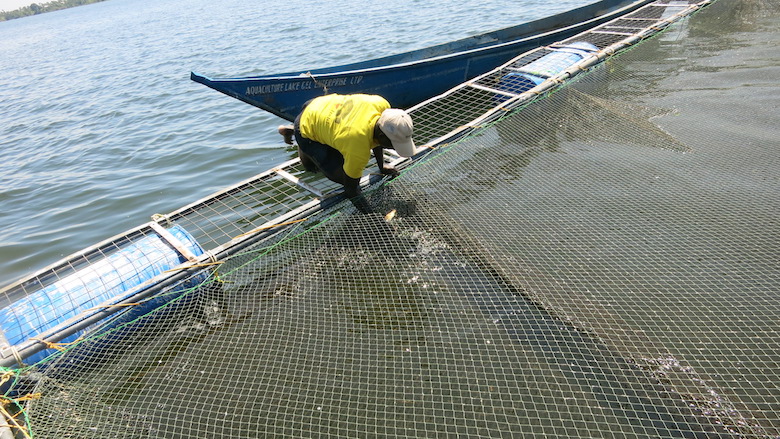
“As people continue to invest in this business, we need rules that will guide establishment and operation of cage fish farming and aquaculture parks in East Africa in a manner that ensures profitability and minimal impacts on the social and natural environment,” said Munguti.
The guidelines will also ensure that people do not introduce any more foreign fish species to the lake.
According to proposals under negotiation, would-be fish-farmers must first obtain a provisional license to operate. This would require a report confirming that their chosen site is suitable, as well as a report on the economic, environmental, and social impacts of their project, which must be approved by their national environmental management authorities. Then, to obtain a practicing license, they must obtain a report certifying that they complied with operating regulations for a period of time.
Embracing cage farming — despite warnings
Lake Victoria’s fishing community has embraced cage aquaculture wholeheartedly.
“We have already seen fishermen form cooperative societies, where they put resources together to make cages, then contribute money to buy and feed the fingerlings, and later share the profits once the fish is sold,” said Otieno.
The Dunga Beach Management Unit (Dunga BMU) is one fishermen’s group investing in cage aquaculture. Its first attempt was with eight cages and 10,000 Nile tilapia fingerlings, which it harvested recently.
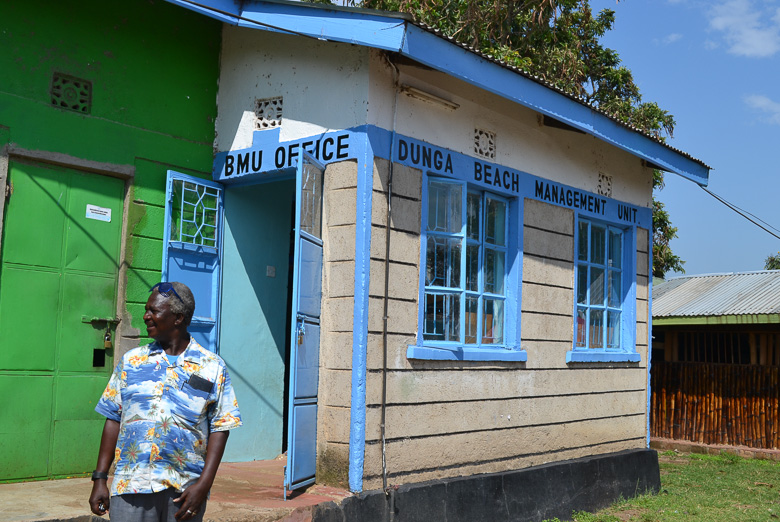
At the moment, the group has four bigger cages on the lake with 20,000 tilapia fingerlings that it will harvest in nine months time.
“In our first trial, we had 100 percent survival of the fish in the cages and we sold everything in bulk to four hotels in Kisumu City,” said Paul Ochieng Okuta of the Dunga BMU. The 16 members of the group shared part of the money and ploughed the rest back into constructing the second set of cages.
Kisumu City-based African Blue is another company that has invested thousands of dollars in cage aquaculture on Lake Victoria, with 40,000 tilapia due to be harvested any time now. The company employs 12 young men and women to take care of the cages. In addition to producing tilapia and tilapia fingerlings using cage technology, the company, which was registered in Kenya in 2014, also intends to offer trainings in sustainable cage and pond fish farming.

One big advantage of cage aquaculture, according to Otieno, is that the fish are easy to monitor. “It is much easier, unlike the ordinary way of fishing using canoes where fishermen spend the entire night on the lake,” he told Mongabay.
The system also locks out predators. Overall, the fish’s chances of survival are much higher than in aquaculture ponds.
Proponents of cage aquaculture say it can address problems like overfishing and the harvest of juvenile fish, and that in turn will improve the lake’s fish stocks and create sustainable income for the fishing community.
“If fishermen find it profitable to invest in cage aquaculture, then we will minimize many problems associated with fishing … on Lake Victoria,” Otieno said.
Even so, cage aquaculture has caused problems in other parts of the world. In the U.S. state of Michigan, for instance, state senator Rick Jones introduced legislation to ban the technology in the Great Lakes because of its propensity for polluting water bodies.
“Concentrated fish poo is just not Pure Michigan,” the senator said in a statement on his website. “A typical 200,000-fish operation creates as much waste as a city of 65,000 people, which would make the Great Lakes a giant toilet bowl,” he said.
Nevertheless, a 2015 study in the journal SpringerPlus investigating the impacts of a small-scale installation of nine cages (each two meters cubed) in a Lake Victoria bay found that the technique caused no consistent environmental changes. It recommended that the technique could be allowed in the lake, but with close monitoring of its impacts.

However, some experts still agree with the Michigan senator that cage fish farming, if not well managed, can cause harmful physical, chemical, and biological changes in the aquatic environment, as has occurred elsewhere. These result from the use of chemicals and cage materials and from the release of waste products, such as dead fish, uneaten feed, and feces, according to Alio Andrew. Andrew is the Assistant Commissioner Aquaculture Management at Uganda’s Ministry of Agriculture, Animal Industry and Fisheries.
But in Kenya, the advent of cage aquaculture is part of the government’s broader plan to boost fish farming generally in order to improve the country’s fish production. Following introduction of its Fish Farming Enterprise Productivity Program, KMFRI notes that national aquaculture production grew from 1,000 metric tons per year in 2000 (equivalent to 1 percent of the national fish harvest) to 12,000 metric tons in 2010. It is projected to hit 20,000 metric tons (equivalent to 10 percent of the national fish harvest and valued at $22.5 million) by the end of this year.
In addition to Nile tilapia, African catfish (Clarias gariepinus), common carp (Cyprinus carpio), and trout (Oncorhynchus mykiss) are among the species cultured, up till now typically in fish ponds. If the Nile perch cage trials are successful, then the species will add to the growing number of fishes that can be farmed in Kenya and in the entire East African region.
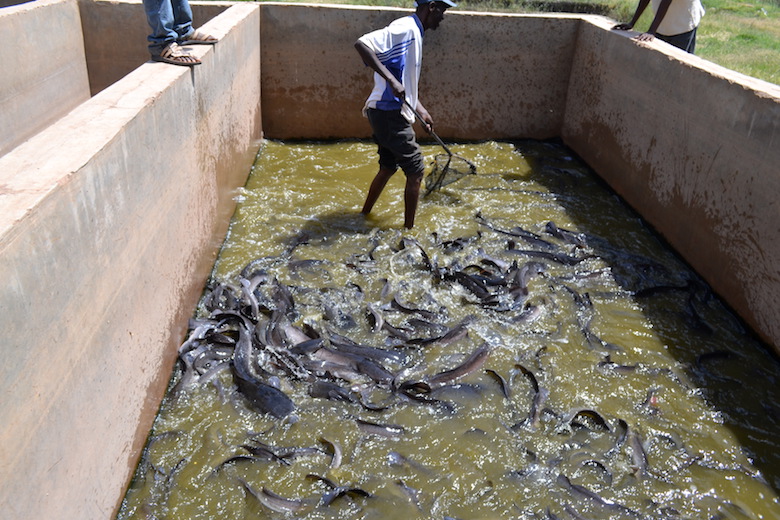
Cage culture “offers the single largest opportunity to increase fresh water and marine fish production in the country, and can easily be taken up as an additional occupation by the fishing communities,” said Munguti of KMFRI.
He noted that Kenya has a coastline of 640 kilometers, including islands and many deep, protected bays where multispecies cage farming can be developed.
“Cage farming is the way to go,” Michael Sigu of Dunga BMU told Mongabay. “Through our association, we intend to introduce many more cages in the lake so that we can have a structured fish farming system,”
So far, Kenya and Uganda have embraced cage aquaculture and are conducting research to improve it. Other countries in the region are expected to follow suit.
Citations
- Kashindye, B.B., Nsinda, P., Kayanda, R., Ngupula, G.W., Mashafi, C.A., Ezekiel, C.N. (2015). Environmental impacts of cage culturein Lake Victoria: the case of Shirati Bay‑Sota, Tanzania. SpringerPlus 4:475.